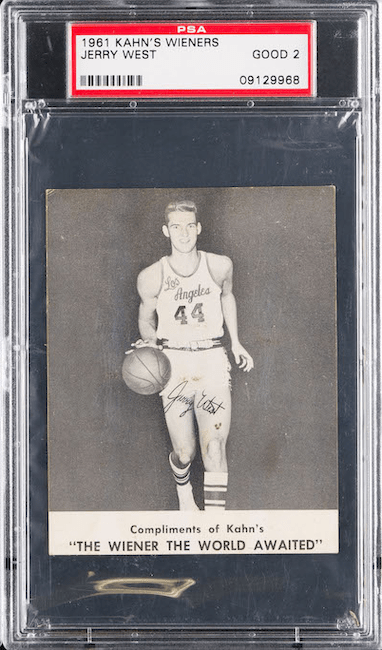Basketball fans know Jerry West as a great player and a highly successful NBA executive. And a lot of collectors treat his 1961 Fleer basketball as his rookie card. However, others feel the 1960 Kahn’s Wiener card, which predated the Fleer release by a year, to be his true rookie card. Whether or not a regional oddball qualifies as a rookie card, the Kahn’s card is pretty incredible. They went on to make three more Jerry West basketball cards as well. Still, they can be tough to classify when in raw form, so I’m going to run down Kahn’s basketball sets, explain the differences between each of the four cards, and discuss a few more details about West’s four Kahn’s Wieners basketball cards.
Kahn’s Wieners released basketball sets between 1957 and 1965. They’re one of the few basketball food issues of the era and are pretty rare, particularly in excellent condition. That’s because Kahn’s was a Cincinnati-based meat processing and distribution company (now owned by Tyson Foods) that packaged the cards with hot dogs.
Given their regionality, Kahn’s sets featured players of the Cincinnati Royals. However, for four years, they also included a card of Jerry West (1960-1963). It’s suspected because he was from the area (West Virginia) or as a brilliant marketing move, as West was a really popular player.
The first Jerry West card that Kahn’s Wieners released was in 1960.


The front of the card features a black-and-white photo, West’s facsimile autograph, and Kahn’s slogan along the bottom. The rest of the 1960 Kahn’s cards had player vitals, a short biography, and statistics. But the back of West’s 1960 Kahn’s basketball card had vitals and a more extended biography because he hadn’t yet played a season. I like how they projected West being a star for years to come.
The 1960 Kahn’s Wieners Jerry West is a BIG card for major basketball collectors, particularly those who consider it his true rookie card. The PSA 8 pictured above sold for $21,600 in Robert Edward Auctions’ Spring 2017 auction. PSA has graded 33 of these Jerry West cards.
The 1961 Kahn’s Wieners Jerry West card used the same photograph as the 1960 card but has a smaller facsimile autograph in black ink. Also, the backs of 1961 Kahn’s Wieners cards are blank.


The 1961 Jerry West card is slightly less scarce than the 1960 card; PSA has graded 43 of them. Here are a few historical sales: $540 for a PSA 1 in September 2022, $900 for a PSA 2 in March 2022, $244 for a PSA 2 (MK) in October 2020, $179 for a PSA 6 (MK) in September 2018, and $3861 for a PSA 9 back in 2012.
In 1962, Kahn’s Jerry West card used a new image. The back of West’s card has a short biography but no statistics, like the other Kahn’s cards that year.


PSA has only graded 34 1962 Kahn’s Jerry West oddball basketball cards, and the last public sale I could find was a PSA 3 at Robert Edwards Auctions for $930 in July 2021.
In 1963, Kahn used the same photo of West as they did in 1962. However, the 1963 Kahn basketball cards have a white border around the front. Also, the facsimile autograph on the front of the card is in white text in 1963, instead of the black used on West’s 1962 card. Be aware that I have seen a mislabeled Kahn’s Jerry West basketball card on the market where PSA got the year wrong.


PSA has authenticated 29 1963 Kahn’s Wieners Jerry West basketball cards. In September 2022, Memory Lane Inc. sold a PSA 1 for $300, which Goldin had also sold (the exact same card) for $300 in January 2022. A PSA 3 sold for $300 in May 2017, and a PSA 9 sold for over $5k in December 2014.
While these Kahn’s cards don’t get as much respect in the market as Fleer and Topps do, the Jerry West cards are great, and it’s undeniable that Kahn’s had successful regional runs with these sets. So, if you’re looking for a challenge in the hobby, getting your hands on all four of Jerry West’s Kahn’s cards is probably just behind the difficulty of getting a bunch of the in-era George Mikan oddballs.
Happy collecting!













































